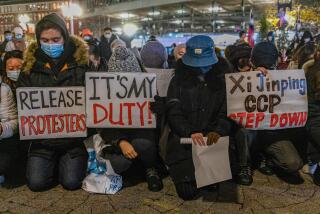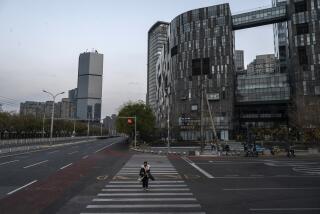Chinese City of Harbin Still Home for Russians, Poles : Few Emigres Left in Paris of the Far East
- Share via
HARBIN, China — It was a Polish holiday, and Edward Stokalski, 68, had invited a few of his Russian friends over for dinner. He had laid out a plate of sausages in his tiny, two-room wooden house and had put on his best suit.
“Now, we just live, and as for the future, no one knows,” one of the Russian guests, all emigres, said after a round of toasts.
Stokalski and his guests could ignore the tension of the last few years between the Soviet Union and Poland because it has passed them by. They share a common bond: They are among the last few dozen Eastern European residents of Harbin, the Manchurian city in northeast China that once had more than 100,000 foreigners and was known as the Paris (or Moscow) of the Far East.
Some of these East Europeans, among them Stokalski’s parents, came here at the end of the 19th Century to build the railroad that runs from Europe through Siberia to Vladivostok. Others are White Russians and Jews who fled after the Bolshevik Revolution.
Most of them left China decades ago, going back to Eastern Europe or to places like Australia. However, a handful stayed on in Harbin, surviving the Japanese occupation, the Chinese civil war, the Communist takeover, and Mao Tse-tung’s Great Leap Forward and Cultural Revolution.
Now, there are indications that Harbin may be getting a new influx of people from the Soviet Union. In July, China and the Soviet Union signed a five-year, $14-billion agreement under which the Soviet Union will help to modernize some of China’s industrial installations.
Much of the Soviet assistance will come to Manchuria, where the Soviets built dozens of factories in the 1950s. Here in Harbin, a city of 2.5 million people, a Soviet navigation group has completed an inspection tour of waterways and industrial enterprises, apparently laying the groundwork for future economic ties.
The Russians who come to Harbin now will find Eastern European institutions throughout the city but little life in them.
Harbin’s largest Russian Orthodox Church was torn down in a single day by young Red Guards at the height of the Cultural Revolution. Of the 18 Russian Orthodox Church buildings remaining in the city, only one is still being used for its original purpose. One has become a warehouse for a department store; another has been turned into a car repair shop; a third is now a Catholic Church.
“Hold high the banner of patriotism . . . take the road of independence and the autonomous church,” says a sign on the Orthodox-turned-Catholic church, in effect telling worshipers to forsake all ties with the Vatican in favor of the independent Chinese Patriotic Catholic Church, which is favored by the authorities in Peking.
The parish priest, Cheng Ganqian, said he was delighted to make use of the church, because Catholics in Harbin had no place to worship during the 1966-76 Cultural Revolution. He said that Jiang Qing, Mao’s wife and one of the leaders of the Cultural Revolution, “wouldn’t allow it.”
Sole Survivor
Once there were approximately 10,000 Russian Jews in Harbin. Now, there is apparently only one, an elderly, emaciated and bedridden woman named Hannah Agre who stays alive with the help of elderly Russian friends.
One of Harbin’s old Jewish synagogues now serves as the No. 2 Korean Middle School, where Harbin children of Korean descent learn to write Chinese characters. The top floor of another synagogue serves as a club for elderly Communist Party cadres.
Any new Soviet advisers who come to Harbin will find a cemetery containing the graves of about 200 Red Army soldiers said to have died in World War II. The cemetery is walled off and overgrown with weeds, a striking symbol of the enmity between China and the Soviet Union that has prevailed for most of the last two decades.
Estimates vary but it appears that there are about 40 Russians left in Harbin from the huge community that was here early in the century.
‘I Love Russia’
“I’m a Russian,” Vladimir Dzinchenko said. “I love Russia. I love Russians. But not everything there pleases me.”
Dzinchenko, 49, who works in a local dairy, was one of the guests at Stokalski’s party. Dzinchenko’s parents settled in Harbin in 1921 after fleeing the Russian revolution. He describes himself as an old-fashioned person and a devoutly religious member of Harbin’s surviving Russian Orthodox Church. Conditions for Russians living in Harbin have improved greatly in the last few years, he said, and added:
“In the Cultural Revolution, no one would greet us. They would turn their backs on us. I couldn’t have talked to (a reporter) then, either. I could talk to other Russians, but not to anyone else.”
A year ago, Dzinchenko married a young woman who is of mixed Russian and Chinese descent. Other Russians here said they never married because they thought their life in Harbin would be temporary and that having a family would make them less mobile.
“We always had an idea to marry after we leave to America or Australia,” said Mikhail Mertov, 73, a White Russian who lives here with his brother Alexei, 76. The Mertovs came to Harbin as children, in 1919.
Sought Return of Property
They have not left because they have had problems getting the proper papers and, like some others in the European community here, they stayed on to try to get repayment for property they lost after the Communists came to power in 1949.
Stokalski, too, lost property. “In the past, I had a lot of houses,” he said, “but all of them were confiscated by the government in 1958 except for this one.
Harbin authorities have agreed to pay Stokalski for the houses but there is still no agreement on the amount. He is being offered much less than he believes the houses are worth.
Stokalski said the most difficult period in Harbin was during Mao’s Great Leap Forward, which turned into an economic disaster. “In 1960,” he recalled, “there were very few products here and almost no food.”
He said Red Guards destroyed cathedrals, paintings, icons and “everything of value.” Harbin, he explained, no longer has the luster it once had.
“Before, Harbin was very beautiful; it was a small Paris.” he said. “Now it doesn’t look like Paris.”
Stokalski and His Dog ‘Bubi’
Stokalski is retired from his job as a mechanical engineer and lives alone with his dog, “Bubi.” He said he spends his days meeting with local officials to try to resolve the property dispute and traveling to a cemetery outside Harbin to visit the grave of his mother, who died here in 1973.
Four of Harbin’s Russians are housed at the retirement home for foreigners, the only one of its kind in China. When it was set up, in 1954, the home had about 200 foreigners living in it. The number has dwindled to 14, including three Japanese, four Koreans, a Chinese from abroad and two stateless Americans.
The Americans are Marjorie Fuller, 62, and her mother, Seraphine, 80. Both were born in China and refer to themselves as “Bamboo Americans.” They renounced their U.S. citizenship in 1930 after Seraphine Fuller divorced her American husband.
Marjorie Fuller said she and her mother decided to stay on in China after the civil war ended in 1949 because they felt that life under the Communist regime would be “democratic.” In 1959, though, they were locked up in a labor camp on the outskirts of Shanghai and kept there with other stateless persons for 21 years.
Marjorie Fuller speaks fluent American English and no Chinese at all, though she has never been outside China. Asked whether she would like to have her American citizenship back or to travel to the United States, she replied:
“No, it’s too late now. Too many years have passed.”
More to Read
Sign up for Essential California
The most important California stories and recommendations in your inbox every morning.
You may occasionally receive promotional content from the Los Angeles Times.












